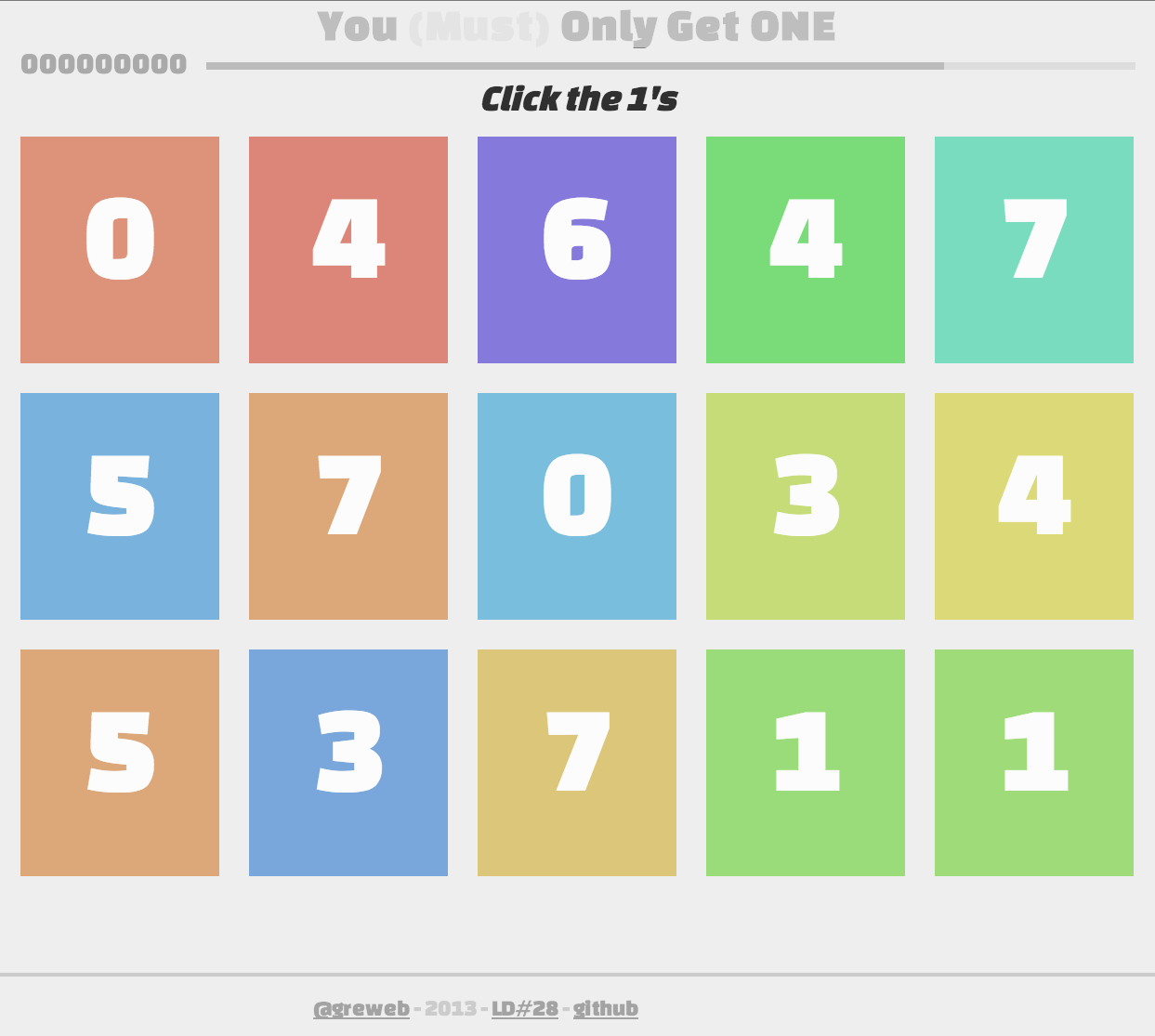One month ago was the LudumDare #28 gamejam theming "You Only Get One".

I submitted a mini-game which ranked 105th out of 2064 entries and also 26th in the "theme" category.
This is of-course a web game implemented in JavaScript and using HTML and CSS.
But actually, my main goal was not really making a game done but more about technically making a state-of-the-art Promise-based game.
I think Promises contains very interesting advantages in a game development design: Resource loading managment, game scenes chaining, animations... are some use-cases.
- Checkout the source code on Github -
src/app.jsis the entry point - LudumDare entry is here.
- Play the Game.
FP in game development
Using some Functional Programming paradigm in game development is interesting, and here I'm just talking at least about the basic stuff: Avoid globals, Minimize state variables.
I've written a few games where restarting the game without using location.reload() was a challenge
because the game variable states was so spread everywhere!
By doing more FP, you can have this restart feature by design without need to "reset" all variables because your start function just takes everything it needs in parameter and restarting is just about re-calling that function.
Promises as first-class citizen
Game scenes chaining
Like maybe 99% of games, my game has an intro (menu), a main scene and an outro scene (gameover / finish).
When you develop a game with just one big render() loop,
it easily becomes a pain when you want to add more steps to the scene,
it doesn't scale and fastly become spaghetti code:
you tend to have to figure out in which state you are (or which part of the animation timeline) from the game state.
Hopefully, scene management is very easy to do with Promises:
function start () {
return Q()
.then(intro)
.then(_.partial(runMiniGames, 20))
.then(outro);
}
Q.all([/*..something to load..*/])
.then(start/*, ..*/) // start game when ready
.done(); // just help Q to trigger errors if some.
How beautiful to read! Call intro then run 20 mini-games then perform outro.
No game state shared, pure functions
intro is the menu screen where you can choose the game difficulty. outro is the game end screen where the final score is displayed. There is however no global variables shared, those are just passed from one function to another.
Let's look deeper in how it works:
- The
intro()function just returns a Promise resolved when the user made a "difficulty" choice. That Promise actually contains the difficulty (0, 1 or 2). - The
runMiniGamesfunction takes 2 parameters: the number of games and the difficulty._.partial(runMiniGames, 20)is just an helper for making a 20 mini-games function which takes the difficulty in parameter. This difficulty is given by the previous Promise. TherunMiniGamesfunction returns a Promise of Score (integer). - That score is then fed into the
outro(score)function which displays this score to the user.
TL;DR. This is just about plumbing 3 functions together!
Checkout also the runMiniGames implementation.
Speed up the development
And you know what? It make development easier and faster because you can easily skip some part in any Promises chain:
function start () {
return Q(0)
//.then(intro) // Directly jump to the games
.then(_.partial(runMiniGames, 20))
.then(outro);
}
I used that a lot and not only for this part, but for all part during the game development.
Loading resources
Promises also help you to wait resources before starting the game. You don't have to make yet another loading library, Promise already are ready for that, and you can also have proper error managment or even "progress" loading display (Q has Progress event in a Promise).
Each loading resource is a Promise and you can combine them all using Q.all.
Here is an example using Qajax and Qimage.
Q.all([
Qajax("music.wav").then(mapToAudio),
Qajax.getJSON("map.json"),
Qimage("images/logo.png"),
Qimage("images/textures.png")
]).spread(function (music, map, logo, textures) {
// Start the game !
}, function (error) {
// display proper error
}, function (progressEvent) {
// maybe you want to display a loading progress bar
// with that third progress callback.
});
Here is a similar example:
var musicPromise = Qajax("music.wav").then(mapToAudio);
var mapPromise = Qajax.getJSON("map.json");
var texturesPromise = Qimage("images/textures.png");
Q.all([ mapPromise, texturesPromise ]).spread(startGame, errorLoading);
// because maybe you don't want to wait the music for starting the game:
musicPromise.then(function (a) { a.play(); });
function startGame (map, textures) {
// ...
}
function errorLoading (e) {
// ...
}
Mini games workflow
My games is divided into a set of mini-games which are all independent but share a common interface. This interface was quite a WIP at the end of the weekend development but it does the job.
Here is the template I used for my game: src/games/_template.js.
A Game instance has different methods, and especially enter and leave method which are call on game enter and on game leave. It also has a .end Promise which is resolved when the Game end.
- A mini-game when solved gives a score depending on how well the user succeed it (through the
endPromise). - A mini-game have a timeout and if the player doesn't terminate it, it passes to the next game without scores.
Those enter() and leave() methods return Promise in order to be plugged in the game workflow (we can wait them to finish before moving to next state).
For instance, we don't start the game timeout before it actually starts (just wait the enter() Promise to be resolved) and also we don't switch to the next game before the leave() Promise is done).
Checkout also the nextMiniGame implementation.
The result of that function is the score of the mini-game and that we sum up all scores from the previous score.
Composability
The enter() and leave() methods can be composed of animations which can themselves be composed of animations.
We can easily subdivided work into different level of Promises chain. Here is a little schema to summary that composability:
Promise Animations
In my game, all the animations are controlled with Promises more exactly using CSS3 Transitions via Zanimo Promise library because it fits my game (DOM-based game). The fact that a Promise can be waited and chained gives a powerful controls over CSS Transitions for making animations.
You can easily trigger animations one after another for moving an element in multiple places. You can also perform multiple animations at the same times (on 2 different elements) and wait for both to finish before triggering a third animation.
See for instance how enter() and leave() animations are done in mini-games.
In the animation ending the "memo" game I used concurrent animations: all memo cards are randomly moved out.
/* // FYI
Card.prototype.transform = function (x, y, scale, duration) {
return Zanimo.transition(this.el, "transform",
"translate("+x+"px, "+y+"px) scale("+scale+")", duration||0);
};
*/
function animateOut (dispersion) {
return Q.all(_.map(cards, function (card) {
if (card.destroyed) return Q(); // no animation because card is destroyed
return Q()
.then(function(){
return card.transform(card.x, card.y, card.number === 1 ? 1 : 0.8, 100);
})
.delay(Math.floor((card.number===1 ? 500 : 0)+300*Math.random()))
.then(function () {
var x = Math.round((Math.random()<0.5 ? -card.w/dimensions.width-dispersion*Math.random() : 1+dispersion*Math.random())*dimensions.width);
var y = Math.round((Math.random()<0.5 ? -card.h/dimensions.height-dispersion*Math.random() : 1+dispersion*Math.random())*dimensions.height);
return card.transform(x, y, 0, 500);
});
}));
}
// Usage in Memo.leave() :
return Q.delay(50)
.then(function(){ return animateOut(0.5); })
.delay(100);
In the calculation game I used a chain of animations subdivided in functions:
return Q.delay(50)
.then(fadeOutInvalids)
.then(displaySolution)
.then(displayEquality)
.delay(500)
.then(fadeOut)
.then(hideEquality)
.delay(200);
"Wait for next click"
While my game are just based on click user interaction,
I've made a waitNextClick function
which returns a Promise of click for the given element.
var Q = require("q");
module.exports = function waitNextClick (btn) {
var d = Q.defer();
btn.addEventListener("click", function listener (e) {
btn.removeEventListener("click", listener);
d.resolve(e.target);
}, false);
return d.promise;
};
This was quite an interesting solution which is just like a jQuery "once" event but in Promise paradigm.
I was able to combine that function with Q.race which wait for one of the given Promise to be redeemed.
Q.race(_.map(btns, waitNextClick))
For instance in the cats game, I just wait the first "This one" button to be clicked:
var houseChoice = Q.race(_.map(this.houses, function (catHouse) {
return waitNextClick(catHouse.btn)
.then(function () {
return catHouse;
});
// houseChoice is a Promise of House choosen by the player.
Using the "progress" event
I also used a bit the "progress" event of a Q Promise, which is a way to notify that a Promise is being resolved.
- I used that "progress" event on the
game.endPromise for notifying that the player is winning some scores in a mini-game while playing. - I also used it to make a timeout ticking the remaining time before the timeout is reached and that Promise resolved.
See both usages here:
return Q.race([
gameEnd
.progress(function (score) {
stats.setScore(totalScore+score);
}),
timeoutWithTicks(gameEnd, timeout)
.progress(stats.setTimeProgress)
.then(_.bind(game.submit, game))
]);
Code organization using NPM + Browserify
NPM & Browserify has also been used because I find this stack very productive, especially when writing a game from scratch.
Browserify has been trendy the last past year, but there is here an interesting way of organizing your code
and especially reusing it.
You can find a lot of available modules using NPM,
Browserify will just make you able to require them using require("modulename").

